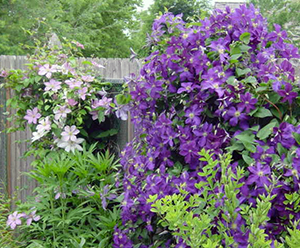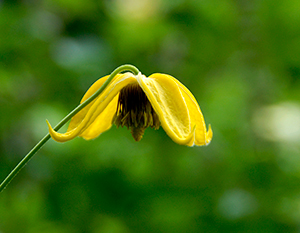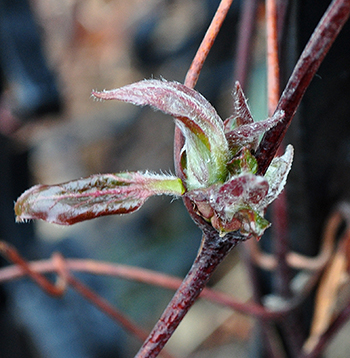Clematis Pruning Made Simple
Growing up as the geeky kid into gardening I remember paging through the garden catalogs. There was page after page of plants with beautiful photos and glowing descriptions that made each plant more desirable than the last. Today we don’t thumb through paper catalogs as much as surf the internet to find the latest and greatest must-haves for the garden.
 Myth: Growing clematis is hard
Myth: Growing clematis is hard
One plant in particular I remember lusting after was clematis. There was the classic ‘Jackmanii’, with its large, showy purple flowers, each one perfect. Somehow I was under the impression that clematis was an exotic hard-to-grow plant. Fast forward to college and a higher level of intellectual study, it was reinforced that clematis were only for prime locations and experienced gardeners.
It wasn’t until years later after I had my own garden I ventured out and tried clematis. Would I be able to grow this plant or would I be wasting my money? The first one I purchased was the classic ‘Jackmanii’. I had wanted one since I was a child. It was a must-have, and since it was the most common variety it had to be an easier variety to grow.
Following all the recommendations I had read I planted it in my garden, which received full sun. Would that be too much? I had always heard they liked a little sun and the roots must have shading as they grew best in sun with cool roots. Where do you find that location in Kansas City? Sun is hot and the soil heats up even more. Nevertheless I planted and to my surprise it grew with little care. I was hooked. I must have more clematis. Soon I had 10 to 12 plants dotting the garden.
 Many different clematis varieties
Many different clematis varieties
There are many colors from the traditional purple to pinks, reds, whites, yellow and bi-colors. Clematis has several different flowering types, from very large showy blossoms to much smaller flowers. There are lily and bell shaped flowers that are delicate and add another element to the garden. They are almost the perfect vine because of the wide variety of choices.
Once I became hooked on them then the real challenge of growing clematis began. Listening to fellow gardeners over the years I learned the challenge with clematis is not about growing the plants. They are easy to grow as all they need is sunlight, a little extra water and a trellis to twine. The real problem is knowing how to prune the somewhat aggressive vines, as they can reach ten feet or more, depending on the variety.
 Simple clematis pruning
Simple clematis pruning
If you’re a novice researching clematis pruning you soon become overwhelmed. There is all this complex talk about groupings. Clematis is pruned into one of three groups based on growth habits. Group 1 pruning are vines flowering in the spring on old growth. Group 2 includes vine types that flower in late spring or early summer and sporadically on new and old growth. Group 3 vines flower in late summer or fall on new growth. I did forget one very important point. You must remember what variety you planted.
At this point most gardeners are bewildered, lost and confused. They start asking themselves: What variety did I plant; what is spring, late spring or early summer; how do I know what is new or old growth? This leaves many gardeners thinking, “These vines must be difficult if I have to know this much information.” It is enough to make you throw your hands up and give up growing this rewarding plant.
After years of working in Extension and attempting to help people learn how to prune clematis I finally got fed up myself with pruning groups. No matter how much time you took people were stuck, mainly because they knew their plant as a purple, pink or white, not as ‘Jackmanii’, ‘Polish Spirit’, ‘Nelly Moser’, ‘Elsa Spath’, ‘Henryi’, ‘Niobe’, ‘Lady Betty Balfour’ or one of the hundreds of other varieties.
Those of you who are “by the book” gardeners will challenge me with my next bit of wisdom. After years of experience and confusion growing clematis, I have adopted an easy to understand strategy. Best of all it works as each year I am rewarded with many flowers and robust growth. What more could you ask for — no brain pruning and happy plants.
 Prune clematis when new growth first appears in early spring
Prune clematis when new growth first appears in early spring
This is how it works. I wait for new growth to appear on my vines. Clematis break bud very early, in late winter. Once the growth has appeared I am ready to prune. Usually you will find a tangled mess of vines with live and dead growth interwoven. Keep in mind the stems of live and dead wood look alike. It is the leafy growth from the buds that indicates a vine is alive.
The simplified method starts at the top of the plant and works down. Start by cutting out the deadwood on each vine of the plant. Work down each vine until you find a live bud or growth. Once you find it stop. Continue to prune all the vines until each is either pruned back to a new growth or to the ground if that shoot is dead. Once this is complete, secure each of the vines to the trellis and move on to the next plant.
If this method is too complicated then here is an even simpler method. Simply cut all of last season’s growth to the ground. The plant will rejuvenate from the base with new shoots. Following this method will result in shorter plants, a few less flowers and the plant will start to bloom a little later. These methods are still based on the groups but it does not require you to remember varieties and looking up which group the plant belongs to. Now this method is not for everyone. If you are the excellent gardener that knows the variety and likes to do the research, find the correct group and prune by the book — don’t let me stop you. But if you are an armchair gardener that just loves gardening and does not get hung up on details I think you will find my clematis pruning for dummies rewarding.
These methods are still based on the groups but it does not require you to remember varieties and looking up which group the plant belongs to. Now this method is not for everyone. If you are the excellent gardener that knows the variety and likes to do the research, find the correct group and prune by the book — don’t let me stop you. But if you are an armchair gardener that just loves gardening and does not get hung up on details I think you will find my clematis pruning for dummies rewarding.
Years later I am still that geeky gardener that likes to thumb through catalogs and try something new. But with age and experience I quickly learned clematis are not fussy and deserve a place in everyone’s garden. I hope I have made the task of pruning simpler for all.
By Dennis L. Patton, M.S., County Horticulture Agent, K-State Research and Extension/Johnson County
Have questions?
The Garden Hotline is staffed by trained EMG volunteers and Extension staff who will assist you with questions. Phone: (913) 715-7050 | Email: garden.help@jocogov.org